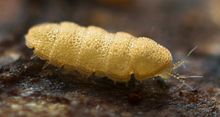Pauropoda
| Pauropoda Temporal range: 40–0 Ma Eocene to Recent |
|
|---|---|
 |
|
| A Eurypauropod from New Zealand | |
| Scientific classification | |
| Kingdom: | Animalia |
| Phylum: | Arthropoda |
| Subphylum: | Myriapoda |
| Class: |
Pauropoda Lubbock, 1868 |
| Orders | |
| Synonyms | |
|
|
Pauropods are small, pale, millipede-like arthropods. Around 830 species in twelve families are found worldwide, living in soil and leaf mould. They look rather like centipedes, but are probably the sister group to millipedes. The name is derived from the Greek roots pauro "few" and podo "foot".
Pauropods are soft, cylindrical animals with bodies 0.5 to 2 millimetres (0.02 to 0.08 in) long. The first instar has three pairs of legs, but that number increases with each moult so that adult species may have nine to eleven pairs of legs. They have neither eyes nor hearts, although they do have sensory organs which can detect light. The body segments have ventral tracheal/spiracular pouches forming apodemes similar to those in millipedes and Symphyla, although the trachea usually connected to these structures are absent in most species. There are long sensory hairs located throughout the body segments. Pauropods can usually be identified because of their distinctive anal plate, which is unique to pauropods. Different species of pauropods can be identified based on the size and shape of their anal plate. The antennae are branching, biramous, and segmented, which is distinctive for the group. Pauropods are usually either white or brown.
Pauropods live in the soil, usually at densities of less than 100 per square metre (9/sq ft).
Though no fossil pauropods have been found from before the time of the Baltic amber (40 to 35 million years ago), they seem to be an old group closely related to the millipedes (Diplopoda). Their head capsules show great similarities to millipedes: both have three pairs of mouthparts and the genital openings occur in the anterior part of the body. Moreover, both groups have a pupoid phase at the end of the embryonic development. The two groups probably have a common origin.
...
Wikipedia
